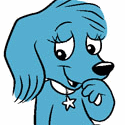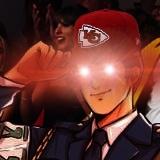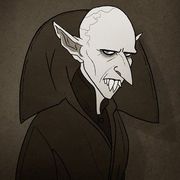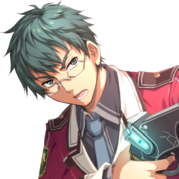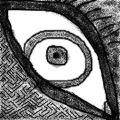|
Though I know it's bunk, I find the idea of telling a story through random cards very interesting. I'd like to know how tarots are best interpreted, some book recommendations on tarot reading (more about the reading side than the scam side, though that's interesting too), and cool tarot decks with good art. Also any sort of tricks or nonstandard tarot uses would be cool too.
|
|
|
|

|
| # ? Apr 25, 2024 14:44 |
|
Alright, I'll bite. The most complete tarot system that I know of is Crowley's. As a consequence, it's very closely tied with his other works and "revealed" esoteric knowledge, some of which he believed came from the highest authority, The Book of the Law, of which he was, of course, the prophet. So there is a certain helping of his ethical system (or lack thereof) and general insufferableness that comes with it, although the vast majority of it is shared with other occult systems, and the essential postulates are everywhere the same. End disclaimer. The hermetic occult tradition ascribes the original designs of the tarot to the ancient Egyptians, who in turn (they assert) believed that they were dictated by the god Thoth, patron of writing. The designs were, of course, just invented in the fifteen and sixteenth centuries as part of a popular card game. The occult significance of the cards were in terms of the exegesis of Jewish texts, primarily the Old Testament, that is generally known as "kabbalah". Kabbalah is such a nebulous and diverse subject that I won't say much about it here, but it should be clear that the tarot is essentially a pictorial representation of concepts in this tradition, where every aspect of God or Creation has its corresponding card, each card having multiple, indefinite meanings. By the time that the Rider-Waite deck (the one you've probably seen) was published in 1910, each card had recorded correspondences to astrological, alchemical, kabbalistic, and various Eastern symbologies, most of which were compiled (or invented) by the Victorian occult society The Golden Dawn. These correspondences were known only to initiates, and were purported to have been revealed and cross-referenced by experiences on the "astral plane", basically a hypnotic form of daydreaming. When Aleister Crowley split with the organization, he published the Golden Dawn correspondences as Liber 777. He designed his own deck in 1943, painted by the art-deco artist Freida Harris, which changed many of the traditional attributions, but resulted in a tighter system that was consistent with his own supposed insight. The good thing about reading Crowley is that practically his entire bibliography is available online. The bad thing about it is that it's a complete clusterfuck, with no clear jumping-off point. Almost all of his papers were written for initiates, and his own companion volume for his deck, The Book of Thoth, is more of a reference for meditation on the symbolism of the tarot than a guide to divination, and so supposes a thorough knowledge of Liber 777. You can read about his theory of divination in general in this chapter (under heading IV) of Magick in Theory and Practice (summary: only the highest initiates can do it successfully), and the whole work is pretty much required reading if you want to get beyond a rough-and-ready knowledge of divining with the tarot. There are probably hundreds of books pushed out by New Age authors writing copy for a penny a word. I'm sure that at least one or two are good, but I've never read any of them. Lon Milo Duquette is a fairly respected occult author and wrote a paraphrase of the Book of Thoth, which looks like as good of an introduction as any. Oh, and you can buy the Thoth and Rider-Waite decks on Amazon.
|
|
|
|
Wow, I had no idea about any of that stuff! Very interesting, thank you.
|
|
|
|
A.E. Waite also wrote a book on how to read his deck. It's not as obtuse, and is written for novices. Here's a PDF of it, but there aren't any pictures: http://www.feedbooks.com/book/4321/the-pictorial-key-to-the-tarot There are probably some online copies with pics. I think it's in the public domain. I personally never got into tarot, even though I'm an occultist. For some reason I can't remember anything about the cards, yet I can remember much more complex things.
|
|
|
|
Why not just make up your own elements? Tell your own story using the cards as a jumping off point for aspects of the story. I think it could beer fun top just kinda make up the 'rules' as you go
|
|
|
|
Jon Joe posted:and cool tarot decks with good art. JoJo's Bizarre Adventure: Stardust Crusaders has what might be my new favorite Tarot deck. It's basically what would happen if the Rider-Waite deck took a bunch of acid while chillin' to the music of Don Felder and Bootsy Collins. http://forums.somethingawful.com/showthread.php?threadid=3616646#post426951458 The designs were apparently based on those of the Rider-Waite deck. If I remember right, the artist for Stardust Crusaders originally intended to use the actual art from the Rider-Waite deck in the story, but had to scrap the idea after finding out the Rider-Waite artwork was copyrighted, so he made his own designs based on the Rider-Waite artwork and used those instead. I don't know if there are any real-life versions of this deck being printed right now or not. At one time there was some sort of JoJo special edition deal that came with actual printed cards, but I have no idea if anybody ever released a full 78-card deck, or if Araki even designed any art for a Minor Arcana at all (the only designs I've seen of his have been from the Major Arcana). If not, then I hope somebody puts something together soon, cuz I'd totally buy that poo poo if I could.
|
|
|
|
Canine Blues Arooo posted:Why not just make up your own elements? Tell your own story using the cards as a jumping off point for aspects of the story. I think it could beer fun top just kinda make up the 'rules' as you go Rory's Story Cubes were well-received by my 8-year-old niece and are great fun. Also as accurate and well-thought-out as Tarot (possibly moreso)
|
|
|
|
Tarot reading is effectively a game of symbolic associations. The symbols that the cards represent are intended to be universally applicable, whether you go by the sephirotic connotations or use some other system. The universal applicability of the symbols is why a reading "works" at all. The narrative that a given set of cards represents seems specific, but is in face insanely general. Because of that, readings are quite fun if you're the creative writing type. You make most of it up based on your knowledge of the person you're reading for and the interplay between the meanings of the cards. Strangely, the more you make up, the greater the illusion of accuracy. Even if you know zero about the person who you're reading for. It's just the shotgun approach coupled with the human need for patterns and narrative, but it can be quite helpful for introspection. I highly recommend trying it out by sticking to one specific system and using it as a tool for creating ideas or introspection. The randomness of the associations can be very helpful in avoiding your own cognitive blind spots.
|
|
|
|
Another surprisingly good use for Tarot cards is using them as a lateral thinking aid. Trying to cram your problem into a half-assed tarot reading and making sense of it sort of forces you to look at your problem from another angle, which often can help you sort it out.
|
|
|
|
Nathilus posted:Tarot reading is effectively a game of symbolic associations. The symbols that the cards represent are intended to be universally applicable, whether you go by the sephirotic connotations or use some other system. The universal applicability of the symbols is why a reading "works" at all. The narrative that a given set of cards represents seems specific, but is in face insanely general. Veryslightlymad posted:Another surprisingly good use for Tarot cards is using them as a lateral thinking aid. Yes this sort of stuff is really awesome.
|
|
|
|
These are really good, helpful replies. I agree that Tarot cards are a great way to exercise your mind and creativity. You can really think about a situation by reading cards on it. Apart from the benefit of forming a story or interpretation of an event through the cards, you're also ordering your thoughts about that situation. Think of it as playing detective to piece together a mystery through a series of questions. (who, what, where, why, when) Imagine, for example, that you have a bad argument with a friend. You're upset and you wonder what happened. What was it really about? You can read the cards and get a better understanding by the way in which you interpret the drawn cards to your situation. Did you get the Tower or Devil? Perhaps that means the problem was a long time coming or that you had behaved badly. Perhaps you read that as meaning the person was in a bad mood, or it may have other, deeper meanings to you. It's likely that, by using the cards as a source of neutral interrogation, you can get some truthful, personal answers. The kind that you might otherwise not be honest with yourself about. And cards can be very handy if you have writers block. If I have any technical advice to offer it's this: There is no such thing as a set meaning for a card, no set meaning for a combination. And every different art set can change the meanings as well. Just follow the flow and you'll be fine.
|
|
|
|

|
| # ? Apr 25, 2024 14:44 |
|
I'll echo what others said about trying to piece together your own thoughts by changing your perspective. I also recommend the Tarot of the Silicon Dawn, it's a personal favorite artwise and has a really distinct, cohesive flavor.
|
|
|






